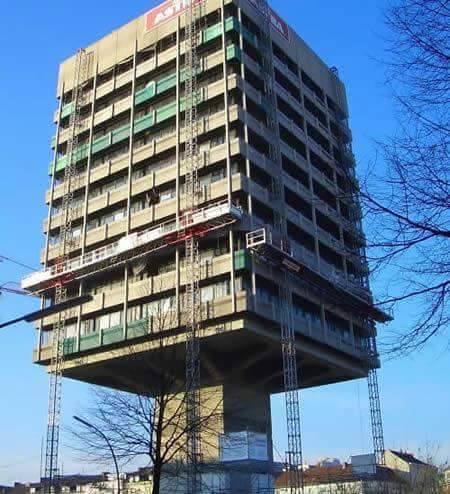-
Posts
578 -
Joined
-
Last visited
-
Days Won
138
Content Type
Profiles
Forums
Events
Everything posted by Ayesha
-

bearing capacity Bearing Capacity in Karachi
Ayesha replied to Usman Altaf's topic in Foundation Design
What is the basis for this? Can you share a geotechnical report or document. How can we trust this information? -

Trainings/ Certifications for Civil/ Structural Engineers
Ayesha replied to Usman Altaf's topic in General Discussion
Best training is self training. Be a self directed learner if you would like to excel in your career. Nothing beats that.- 2 replies
-
- trainings
- conference
-
(and 1 more)
Tagged with:
-
Use MBMA (http://www.mbma.com) guidelines and codes. You need to consider inertia forces from crane to supporting structure that would be applied when the crane stops. All that information is in MBMA guideline. You can also check out the Canadian CISC Crane Supported Structures Guideline. It is freely available, so I have attached it. CISC_crane_support_steel.pdf
-
See this thread.
- 7 replies
-
- shearwall
- column vs wall
-
(and 1 more)
Tagged with:
-
Before you decide the thickness, you need to size the foundation based on bearing pressure so that there is minimum eccentricity if possible. We never want to have high sustained tension on combined foundation. After that you can use one way and two way shear checks to see which one governs.
-
Good suggestion but what about effect of axial load?
-

Statement of Purpose (SOP) Guidance for Masters Application
Ayesha replied to Ajlal Arif's topic in Students Zone
If you have something, share and we can comment or review. -
A rigid diaphragm would not deflect on its own when transferring loads to vertical load resisting system. That is why it is called rigid - all points move the same. A flexible diaphragm however would deflect when doing the same. So for rigid diaphragms, loads are transferred to vertical load resistance system members based on their stiffness, where as for flexible diaphragm, the tributary area of diaphragm to a member is critical in determining how much load gets transferred to it in addition to its stiffness. This is the general principle. There are also two topics on this forum that you can look at. I think the 5% eccentricity check applies to all kinds of diaphragm. I am out of practice for some time so other members can comment on this one if I am incorrect. Check these threads.
-
Make a free body diagram. Corbel transfers loads to column like any rigid attachment to column would. It would transfer a moment and axial load to column. The tough job is to design corbel itself. You should use Strut-and-Tie method for corbel design.
-

Concrete Compressive Strength
Ayesha replied to Engr. Muhammad Usman Khan's topic in General Discussion
1. Tests are based on standards such as ASTM. That is where the cube and cylinder requirement comes from. I don't think so that there is any other method than the standard tests. 2. You need a supervisor to verify that. 3. Depends if lumps are soft lumps or hard lumps. Fresh cements sometimes get soft lumps that go away by pressing a finger. Soft Lumps are do to a phenomenon called "pack-set". Soft lumps are okay. Hard lumps are not and are caused by moisture ingress in cement bags. Cement with hard lumps has already started hydration and would result in lower strength. It should not be used. 4. What is your question? 5. I don't think there is another method. You need to compare the yield of bar against allowable limits stated in ASTM Standard. Limits are different for seismic and non-seismic application. I would suggest that please don't post a lot of questions in one thread as it takes significant time to answer all the questions. -
F11 is what is defined above. You need to trun local axis on to see where is 1-1 direction is. Turn it on and and share the picture here.
-
You can buy it here https://shop.bsigroup.com/en/Browse-by-Subject/Eurocodes/?t=r
-

Statement of Purpose (SOP) Guidance for Masters Application
Ayesha replied to Ajlal Arif's topic in Students Zone
Are you planning for MSC or MENG. SOPs are different based on what you plan to do. -
Check this topic.
-

Reinforced Concrete Design of 3 hinged arch
Ayesha replied to Emejulu JVT's topic in Concrete Design
You can design the reinforced concrete section for a moment of 342kNm like you would do a beam. That is my understanding. I have never designed one. -

Application of 4.5" Masonry Partition Load in Etabs
Ayesha replied to Ahsan Kazmi's topic in Concrete Design
You can apply using dummy lines. -

OVER HEAD WATER TANK CALCULATIONS REQURED
Ayesha replied to Mehreen Iqbal's topic in Concrete Design
Hi Mehreen, Welcome to the forum. See this- 2 replies
-
- rcc water tank
- over head water tank
-
(and 1 more)
Tagged with:
-
See this topic: It depends. I have seen some embassies get blast wall designed considering the terror threat they face. Search the forum.
-

Isolated footing that ensures yielding of column at base
Ayesha replied to Badar (BAZ)'s topic in Foundation Design
Kudos @BAZ -
Plate elements by default consider shear deformations. If you use shell elements, then then would ignore the shear deformation. I think your question should be that Is the analysis using Shell Elements is correct for deep rafts as they ignore shear deformations.
-
What are your specific concerns? Do you want to discuss the important things to consider while designing pick up column?
-
I don't know what the framing is for Faisal Mosque Minaret. However, as per UBC: Also in the sub notes of Table 16-N, the maximum height for Cantilevered Column System is only 35 feet in Zone 3 and 4. Cantilever Column System Geometry is very peculiar. See the attached image as it shows one system. If the minaret framing is similar to attached picture, it is a cantilevered column system. If not, it is something else. Without seeing framing, its hard to tell.
-
Do you mean it has happened for different models or it happens a few times while checking results for the same model.
- 1 reply
-
- torsional irregularity
- etabs
-
(and 1 more)
Tagged with:
-

High Loads under Columns and Bearing Capacity Failure
Ayesha replied to muneeb1213's topic in Foundation Design
You can do any of the following things muneeb. 1) Go further deep to get a better bearing capacity. It would increase the excavation, foundation and project cost. 2) Use deep foundations like piles to support the superstructure load. 3) Increase number of columns so that your load per column gets less and so does force on foundation. 4) Verify loads and manually check load development to make sure that you are not over-estimating any loads. 5) Change roof design so that superstructure load reduces on foundation. Reduce slab thickness if possible or provide a steel truss if that is a possibility instead of concrete slab. 6) Discuss with architect and try to remove masonry walls and partitions and use lightweight equivalents.- 12 replies
-
- foundation bearing failure
- foundation
-
(and 1 more)
Tagged with:
-

Expert opinion on M.Sc. research Topic selection
Ayesha replied to EngrJunaid's topic in General Discussion
Interesting. I also don't have any experience with Similitude Study. I am curious to ask that what is the objective of this study?- 5 replies
-
- ms research
- structural engg
- (and 3 more)



